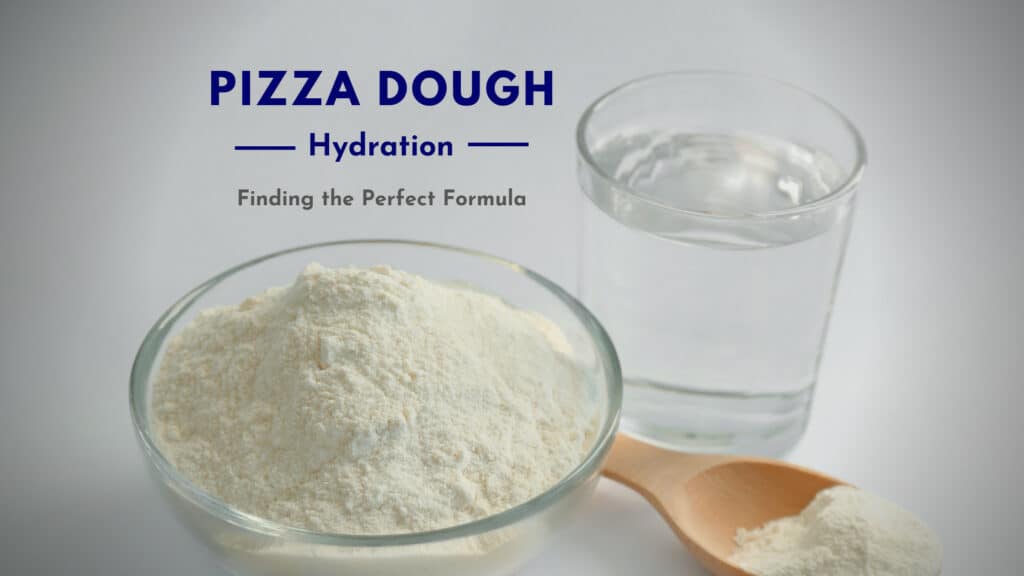Pizza Dough Hydration Explained
Pizza dough hydration is what making a pizza is all about. Getting to know your pizza dough to have just the right amount of hydration is the key to making the perfect homemade pizza.
You will undoubtedly come across pizza dough hydration levels, especially regarding its effect on pizza dough. Pizza dough hydration refers to the amount of water relative to the flour in the dough.
But there is more to it.
So, we’ve created this guide to help you understand the basic principles.
Once you understand pizza dough’s hydration level, which is right for you, and how to adjust your hydration percentage to get specific outcomes for your pizza, it can be a real game-changer.
At first, it can be a little tricky to grasp. But don’t worry; we will explain everything in detail.
So, let’s get started.
Here’s What You Will Find:
What is Pizza Dough Hydration?
Pizza dough hydration is the proportion of water to flour in a pizza dough recipe, expressed as a percentage. The amount of water in the dough affects the pizza crust’s texture, flavor, and overall quality.
A higher hydration level leads to a softer, chewier crust, while a lower hydration level results in a crispier crust.
Pizza dough hydration is a critical aspect of pizza making. It can be adjusted to produce different types of crust, from the traditional Neapolitan-style pizza to the classic New York-style pizza.
For example, if you have 700 grams (milliliters) of water and 1000 grams of flour, and will mean that there is 70% water hydration (700/1000 = .7 x 100= 70%).
Baker’s Percentages
Baker’s percentages are a helpful tool for making consistent and accurate dough recipes, including pizza dough. It’s a way to express the ingredients of a dough recipe as a percentage of the total flour weight. This allows bakers to easily scale their recipes to make different quantities of dough and adjust their recipes based on the desired outcome.
To calculate the hydration level of a pizza dough, divide the total weight of water by the total weight of flour, then multiply by 100 to express the result as a percentage.
A typical pizza dough has a hydration level of around 60-65%, meaning that for every 100 grams of flour, 60-65 grams of water is used. By using baker’s percentages, bakers can easily control and adjust the hydration level of their pizza dough to achieve the desired texture and taste.
What Ingredients Count Towards Pizza Dough Hydration Percentage?
Only liquids such as water or milk would count for hydration percentage purposes in pizza-making. Other ingredients, such as oil, considered fat, are not liquid.
Importance of Pizza Dough Hydration
Hydration is one of the essential elements in mixing pizza dough and in the pizza’s final appearance since the pizza dough hydration percentage level helps the baker control the dough’s composition to the point that you can predict the texture of the crumb.
In pizza, the crumb refers to the pattern and size of holes inside the crust. Generally, the more water in the dough, the more open the final crumb.
You can predict your pizza’s outcome by controlling the water that goes into the dough.
Hydration affects fermentation and how fast or slow your dough will rise.
Hydration also affects the texture of the dough, elasticity, and level of stickiness.
So as you know, the higher hydration percentage also makes your pizza dough rise more quickly. It also tends to make the dough sticky and harder to work with.
Factors that Will Have an Effect on Pizza Dough Hydration
Several factors can affect the hydration level of pizza dough, including:
Type of flour
Different flour types have different absorbency rates, which can impact the final hydration level of the dough. Different types of flour have varying levels of protein and gluten, affecting their absorbency rates and significantly impacting the dough’s final hydration level.
Flour water absorption plays a crucial role in determining the final hydration of the dough, as it directly affects the ratio of water to the flour and impacts the gluten development and texture of the dough.
Flour absorption is commonly measured by a standardized dough consistency test, which determines the ideal amount of water to be added to the flour based on a specific unit of measurement called BU.
BU stands for “Brabender Unit,” a unit of measurement used in the baking industry to quantify the absorption capacity of flour. In a Farinograph test, a certain amount of flour is mixed with water until the dough reaches a standardized consistency. The result is expressed in BU, which represents the absorption capacity of the flour.
The higher the BU percentage, the higher the absorption capacity of the flour. The BU test provides important information to bakers. It helps determine the optimal amount of water needed for a specific type of flour, which is essential for making consistent and accurate dough recipes.
For example, high-protein flours, such as bread flour and pizza flour, have a higher absorbency rate, resulting in a dough with a higher hydration level and a chewy, structured crust.
Conversely, low-protein flours, such as cake flour, have a lower absorbency rate, resulting in a dough with a lower hydration level and a tender, crumbly crust.
Adding Flour During Kneading
Flour absorbs water as soon as it comes in contact with it. Adding flour during kneading affects the dough’s hydration because it changes the water ratio to flour, directly impacting the final product’s texture and elasticity.
If too much flour is added, it reduces the hydration level, and the dough will become stiffer and drier, leading to a denser, less tender pizza crust.
On the other hand, if too little flour is added, the dough will be sticky and difficult to work with, resulting in a softer and less crispy crust.
The key is to find the right balance of flour and water to create a smooth and pliable dough that will result in a delicious, light, and crispy pizza crust. A good practice is to measure by weight, not use a measuring cup for all the flour you plan to use beforehand, and not add any additional flour.
Salt
Salt impacts the dough’s gluten structure and hydration level because it slows down the yeast fermentation process and tightens the gluten structure, making it more rigid. This, in turn, affects the dough’s ability to retain water, leading to decreased hydration.
Too little salt will result in a dough that is overly sticky and difficult to work with, while too much salt will result in a dry and tough crust.
The ideal amount of salt in pizza dough is usually between 2-3% of the total flour weight, which helps to balance the yeast activity and maintain an optimal hydration level for the dough.
Yeast
The amount and type of yeast used can impact the fermentation rate, affecting the dough’s hydration level.
Different types of yeast, such as fresh yeast, dry yeast, and instant yeast, have different fermenting capabilities, and the amount used can affect the speed of the fermentation process.
If too much yeast is used, it can cause the dough to ferment too quickly, decreasing the dough’s hydration level and causing a drier, denser crust.
Conversely, if not enough yeast is used, the dough may not ferment quickly enough, increasing the dough’s hydration level and causing a softer, less structured crust.
Sugar
Sugar can impact the fermentation process and affect the final hydration level of the dough. Sugar in pizza dough acts as a food source for yeast, promoting the fermentation process and causing the dough to rise.
However, too much sugar can cause the yeast to ferment too quickly, decreasing the dough’s hydration level and creating a drier, denser crust.
On the other hand, if there is not enough sugar, the yeast may ferment too slowly, increasing the dough’s hydration level and creating a softer, less structured crust.
Water
Adding water during kneading can increase the hydration level because it increases the ratio of water to flour in the dough. The more water in the dough, the softer and stickier the dough will be. This increased hydration leads to a more tender and chewy crust when baked.
However, adding too much water can make the dough difficult to handle, resulting in a tough, dense crust.
It is important to add the water slowly and in small increments during kneading and to adjust the amount of flour added, as needed, to achieve the desired dough consistency and hydration level.
Inaccurate Measuring
Inaccurate measuring of ingredients can result in a dough that is too dry or too wet, which can impact the final texture and flavor of the crust.
Accurate measuring of ingredients is critical in achieving the desired hydration level in pizza dough. Inconsistent measurements can result in variations in the dough’s texture and flavor, affecting the overall quality of the pizza.
For example, a small discrepancy in the amount of water used can result in a dough that is either too wet or too dry, affecting the final hydration level and altering the texture and flavor of the crust. Similarly, inaccurate salt, yeast, or sugar measurements can also impact the dough’s fermentation process, affecting the final hydration level.
It is important to use precise measurements and consistent techniques when making pizza dough to achieve consistent results. This can be achieved by using kitchen scales, measuring cups, and spoons and following recipes carefully. By measuring ingredients accurately, you can ensure the final dough has the desired hydration level, leading to consistently delicious and perfectly textured pizza crusts.
Mixing time
The time and mixing process used to mix the ingredients can impact the final hydration level of the dough because it affects how the gluten structure is developed. The gluten structure is critical in the dough’s absorbing and retaining water.
Longer mixing times can over-develop the gluten structure, resulting in a dough that is stiff and less able to retain water. Mixing the ingredients too aggressively can damage the gluten structure, leading to a dough with poor texture and a lower hydration level.
The best approach is to mix the ingredients until just combined, using a gentle and slow mixing method, to achieve a dough with an optimal hydration level and a desirable texture.
Resting time
Resting time affects the hydration level because it allows the gluten structure in the dough to relax and absorb more water. After mixing, the dough is often allowed to rest, or “autolyze,” for a short period of time before kneading.
This rest period allows the gluten structure to relax, making it easier to knead and shape the dough and increasing its hydration level.
A longer rest period can lead to increased hydration, while a shorter rest period can result in a dough with a lower hydration level.
The optimal rest time will depend on the type of dough being made, the desired final product, and the temperature and humidity conditions in which the dough is stored.
Humidity
Humidity affects pizza dough hydration because it can change the amount of water in the air, affecting the water content in the dough.
High humidity levels can make the dough softer and stickier, causing it to absorb more water and increase the hydration level.
On the other hand, low humidity levels can result in a drier and stiffer dough with a lower hydration level.
The optimal humidity level for dough making will depend on several factors, including the type of dough being made, the desired final product, and the temperature conditions in which the dough is stored. It is important to control the humidity and temperature to ensure consistent results and maintain the desired dough hydration level.
Altitude
Altitude affects pizza dough hydration because it can impact the atmospheric pressure, which can change the boiling point of water and affect how ingredients behave during the dough-making process.
At higher altitudes, the lower atmospheric pressure can cause the dough to rise faster and absorb more water, increasing hydration.
This can result in a softer, stickier dough that is more difficult to handle. On the other hand, when baking pizza dough at lower altitudes, the higher atmospheric pressure can cause the dough to rise more slowly and absorb less water, leading to a lower hydration level and a stiffer, drier dough.
To compensate for the effects of altitude on dough hydration, it may be necessary to adjust the amount of water and/or yeast used in the recipe.
Baking Temperature
The temperature to bake the pizza can affect the hydration level during the baking process, as high temperatures can cause the dough to dry out more quickly.
These factors can help ensure consistent and accurate hydration levels in pizza dough, leading to consistently delicious and perfectly textured pizza crusts. These factors should be considered when adjusting the pizza dough’s hydration level to achieve the crust’s desired texture and flavor.
The pizza bakes at high temperatures very quickly, and not much moisture is evaporated from the dough.
How Does Hydration Affect Pizza Dough?
Hydration is crucial in pizza dough’s texture, flavor, and overall performance. The dough’s hydration level refers to the ratio of water to flour in the dough, usually expressed as a percentage. Different hydration levels can produce different results, influencing the dough’s characteristics in several ways:
Texture and Crumb:
Higher hydration levels lead to a lighter, airier dough with larger bubbles and a more open crumb structure. Conversely, lower hydration levels create a denser dough with smaller bubbles and a tighter crumb structure. This directly affects the final texture of the pizza crust, with higher hydration resulting in a crispier exterior and a tender, chewy interior.
Handling:
Higher hydration dough tends to be stickier and more challenging to handle, while lower hydration dough is easier to shape and work with. As a result, higher hydration dough often requires more skill and experience to handle properly. In addition, higher hydration dough may require longer fermentation and proofing times, which can affect the dough’s overall flavor and performance.
Flavor:
Higher hydration dough typically ferments slower, allowing for more complex flavors to develop due to the flour’s yeast activity and enzymatic breakdown. Lower hydration dough, on the other hand, ferments more quickly and can have a milder flavor profile.
Oven Spring and Browning:
Higher hydration dough tends to have better oven spring (the rise in the dough during baking) due to the higher water content turning into steam and expanding the dough. This results in a puffier crust. Additionally, higher hydration dough browns more evenly and quickly in the oven, contributing to a more appealing appearance and flavor.
Gluten Development:
Hydration levels also affect gluten development in the dough. Higher hydration helps the gluten proteins to bond more efficiently, resulting in a more elastic dough that can stretch and expand during baking. Lower hydration dough has less available water for gluten formation, leading to a tighter, firmer dough.
In summary, hydration affects various aspects of pizza dough, including texture, handling, flavor, oven spring, browning, and gluten development. Striking the right balance in hydration levels can help you achieve your desired pizza crust characteristics, whether it’s a thin, crispy crust or a thick, chewy one.
Pro Tip
Remember that the coarser flours, like wheat, will take more water. For example, the recipe may call for all-purpose flour, but all you have on hand is wheat flour. … In those circumstances, you must add 5 – 10% more water than the recipe calls for.
How to Calculate Pizza Dough Hydration
Calculating your pizza dough hydration percentage should be easy since your pizza dough recipe will give you how much water you need. If the recipe is in cups, you must weigh your ingredients.
Hydration = Grams of water divided by grams of flour multiplied by 100. Here’s an example:
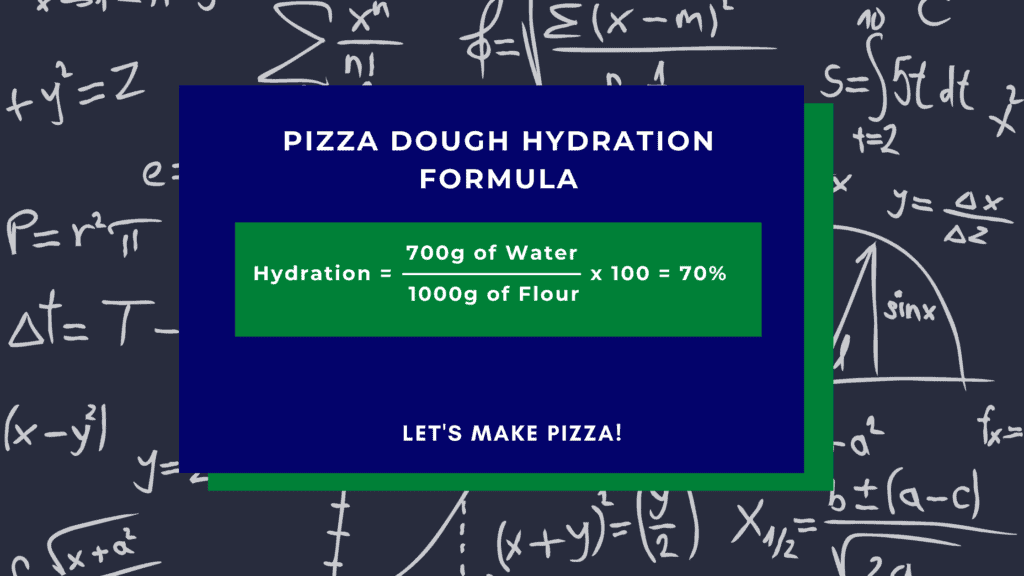
Do not attempt to calculate your pizza dough hydration percentage using cups as the measuring units; it won’t work.
Not to mention that measuring flour in cups will never yield exact results. Find why weighing your pizza ingredients is better than using cups in our Baker’s Percentage Method article.
Decide if you weigh grams or ounces and apply the measuring unit to all your ingredients to simplify the conversion process.
Using grams or ounces will give you the same results. However, using small ingredients is better than using grams rather than ounces.
Why?
No fractions!
Pizza chefs use pounds and ounces in commercial applications because they manage large amounts of dough, so the math is easier to handle in those measuring units.
When making homemade pizza, it is best if you use grams.
Steps to find the pizza dough hydration percentage for any given recipe:
Step 1 – Weigh the flour
Step 2 – Weigh the water
Step 3 – Divide the water’s weight by the flour’s weight and multiply the result by 100.
Example:
A recipe containing 1 1/4 cups of water (285 grams) and 3 cups of high-protein flour (425 grams) will have a 67 percent (285/425 x 100 = 67) hydration level, indicating a moderate airy crumb.
Steps to find the required weight of ingredients for a recipe that is given in Baker’s Percentage
Suppose your recipe is already expressed in percentages using Baker’s Percentage Method. Remember, your flour is always 100%, so all you need to do is multiply the ratio of the particular ingredient by the weight of the flour.
If you don’t want to do the math, here’s our pizza dough hydration calculator to help you out.
Pizza Dough Hydration Calculator
Enter the weight of your flour and water in grams:
If you do want to do the math, here’s an example:
You found a pizza recipe that is given in percentages as follows:
- Flour 100%
- Water 67%
- Yeast 1%
- Salt 2.5%
To find the weight of the ingredients you need, follow these steps:
Your starting point will always be the flour, your desired amount. This could range from 100g to 1000g of flour for homemade pizza.
So, let’s say you want to test 400g of flour, then you calculate the rest of your ingredients based on the 400g of flour. Your dough formula will look like this:
- Water 67% = 400 x .67 = 268g
- Yeast 1% = 400 x .01 = 4g
- Salt 2.5% = 400 x .025 = 10g
You can check our Baker’s Percentage Calculator, which will help you find the percentages of all your ingredients.

Pizza Pun
So I was heating a premade pizza pie, and the instructions told me to put it in the oven at 180 degrees.
Now I’m left with an upside-down pie in an oven.
How Pizza Dough Hydration Affects Pizza Dough Fermentation
Water will affect each of the elements of making pizza. It is best if you think that making the best pizza is achieving a balance between all the elements.
Fermentation
The power of yeast will make your pizza dough rise to the occasion.
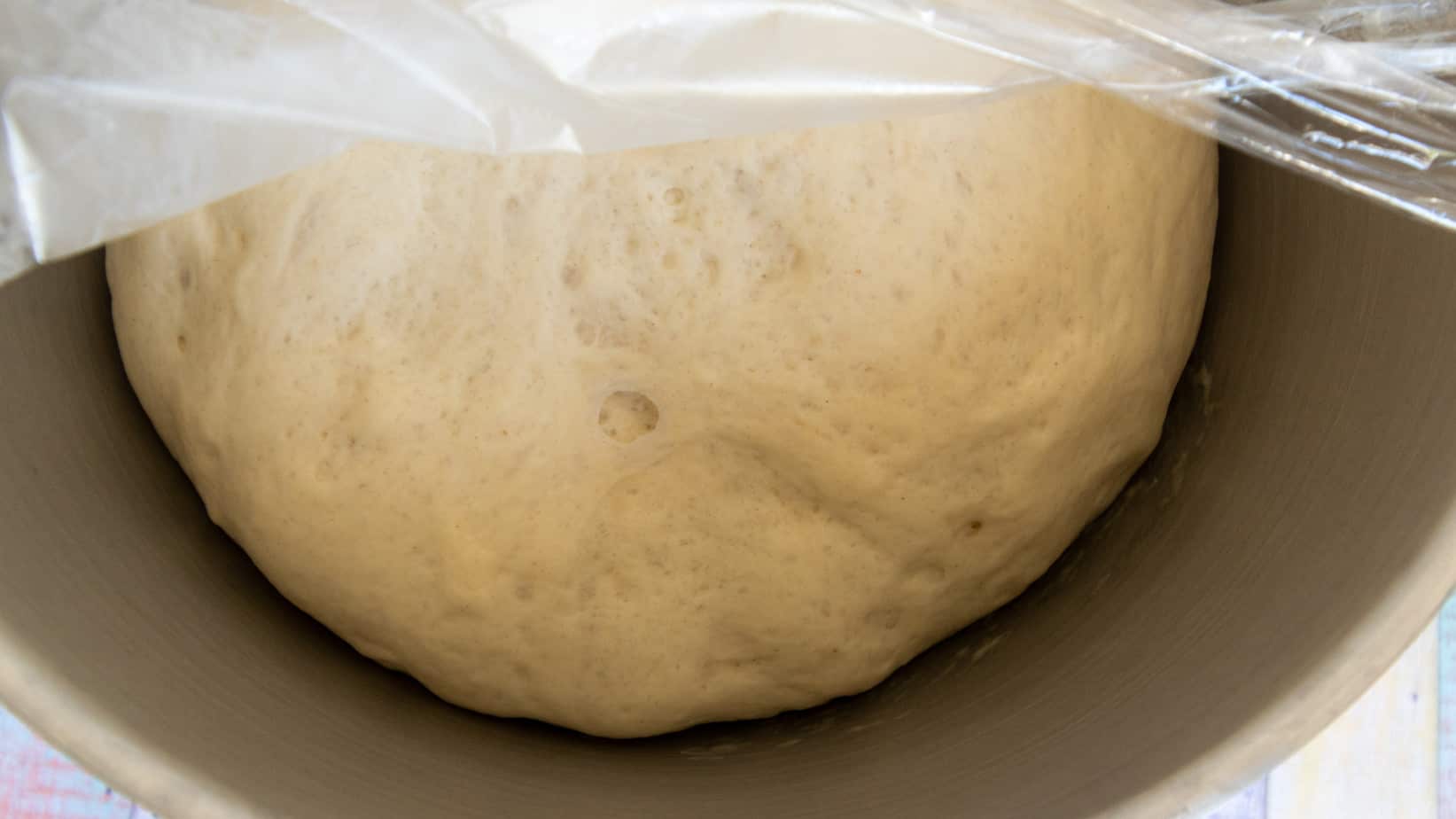
Effect of Pizza Dough Hydration on Fermentation
By adding more water to your flour, you have an accelerated fermentation process.
Lower amounts of water delay the fermentation process, resulting in a slower time for the dough to rise.
This effect is due to the concentration of soluble solids in the dough.
For example, as the water increases, it causes the dough to become softer. The soluble solids are diluted, causing a decrease in the yeast’s osmotic pressure and increasing its activity.
Osmotic pressure measures the tendency of a solution to take in a pure solvent by osmosis.
You need to consider the amount of water when developing or adjusting your pizza recipes. For example, the percentage of yeast should be lowered in the wet dough and increased in the stiffer dough.
Effect of Pizza Dough Hydration on Elasticity
Elasticity
A large amount of water will create a softer consistency in your pizza dough, while a lower amount of water will generate a stiffer texture in your pizza dough.
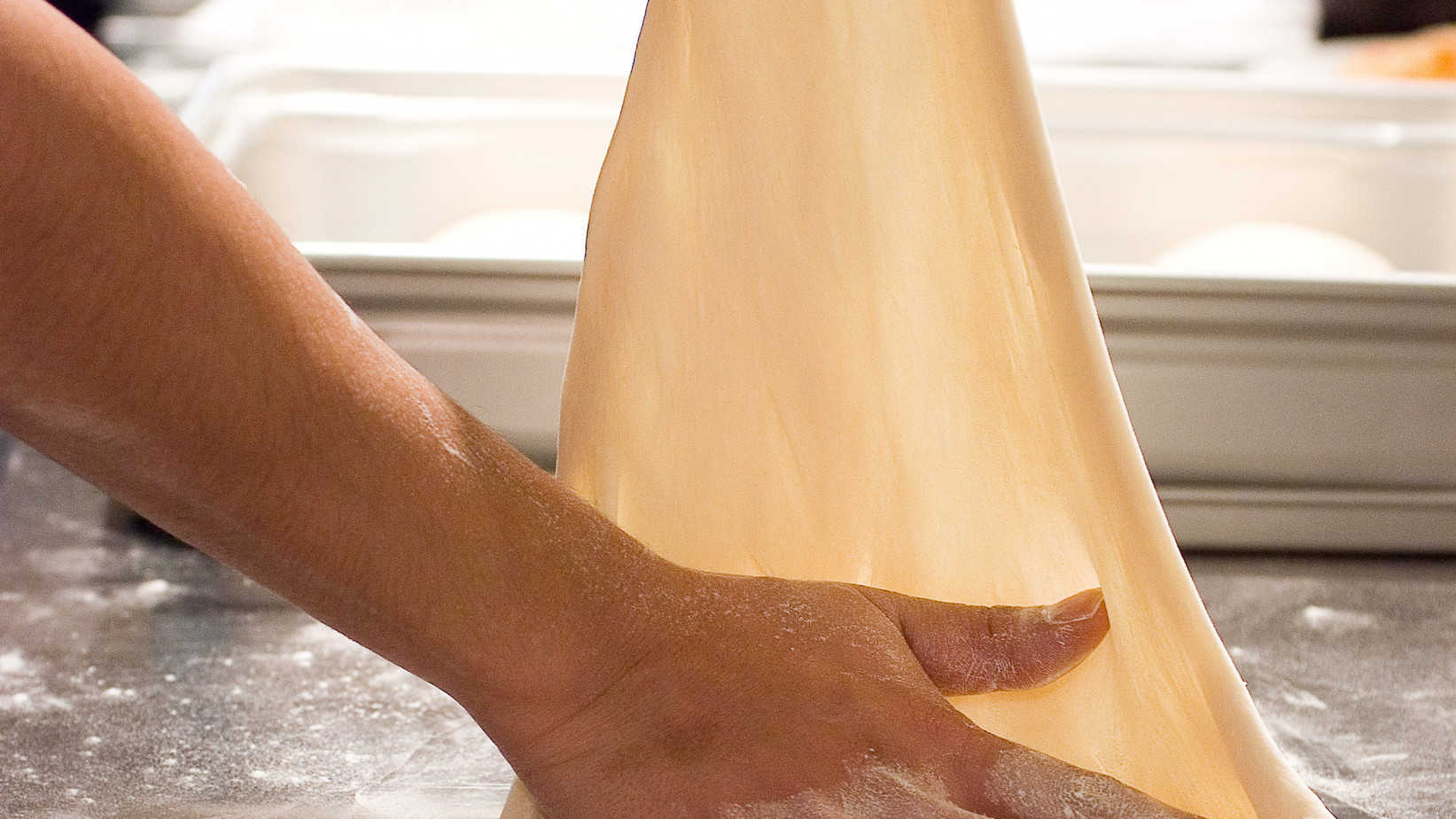
Softer pizza dough will create a weaker gluten structure, more extensible, and less elastic.
Soft Pizza Dough
High hydration doughs benefit from a long fermentation time and sometimes fold during the first fermentation. The final crust will have a more open, chewier crumb structure, airier pizza crust, and a more complex flavor.
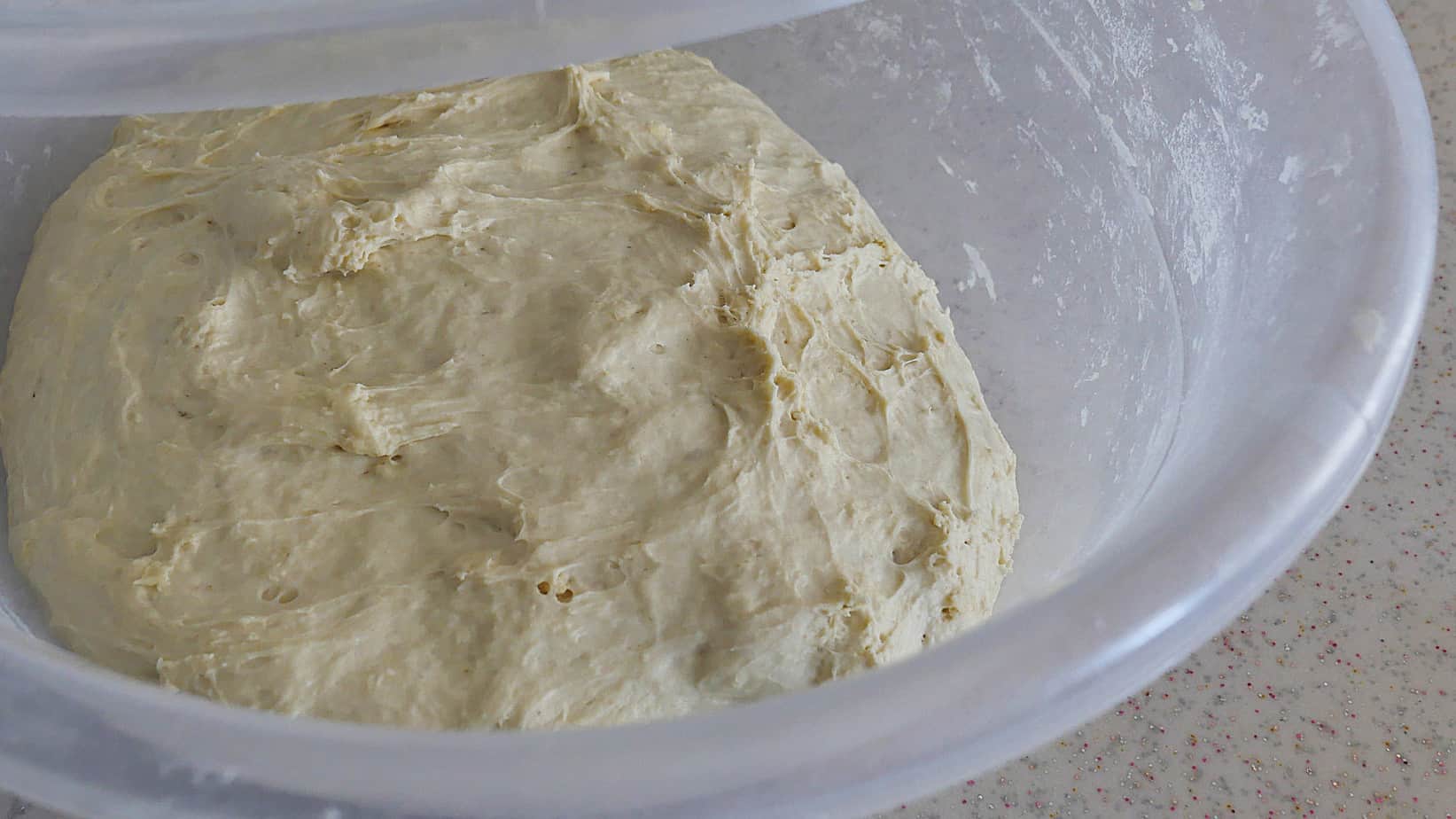
Stiff Pizza Dough
A stiffer dough will create a more robust gluten structure, less extensible, and more elastic.
In this case, a shorter fermentation time will be more appropriate to avoid excess strength during shaping. The final crust will have a tighter cell structure, and the flavor will be slightly bland if there is no pre-fermentation.

Stretchy pizza dough is always fun to work with since it will stretch to incredible degrees. It also has a nasty habit of return elasticity, making it harder to form a perfectly shaped pizza dough circle.
With very elastic pizza dough, you need to stretch out your dough with exaggerated intent. It will take twice the amount of stretch to loosen up the extremely springy dough.
Once you grasp the situation well, the stretchy dough will be easier to handle. This method also depends on how dusted your hands are to keep the stickiness level minimum.
Effect of Pizza Dough Hydration on the Crust Texture
The crust is one of the deciding factors in most pizza styles, from the thin crust ones such as New Haven and New York style pizza to thick crust pizzas such as the Sicilian and the Detroit style pizza.
Water will indirectly affect the pizza crust texture because the texture is related to the fermentation process, and water is just a part of this process.
A higher hydration dough level will produce a softer, chewier crust, while a low hydration dough level will produce a crispier, crunchier crust.
During fermentation, the yeast will eat sugar in the flour and create alcohol and carbon dioxide gas as waste products.
The carbon dioxide gas produced by yeast gives the pizza crust its airy texture, and the alcohol, which burns off during baking, leaves behind one of the most critical components – Flavor!
Ultimately, the goal is to find the perfect balance of hydration to create a delicious and perfect pizza crust.
Effect of Pizza Dough Hydration on Gluten Development
When flour is mixed with water and kneaded, it becomes very elastic. The flour and water mixture in pizza dough becomes stretchy like a balloon because of a wheat protein known as gluten.
Gluten lets the pizza dough capture yeast’s carbon dioxide in tiny flour balloons.
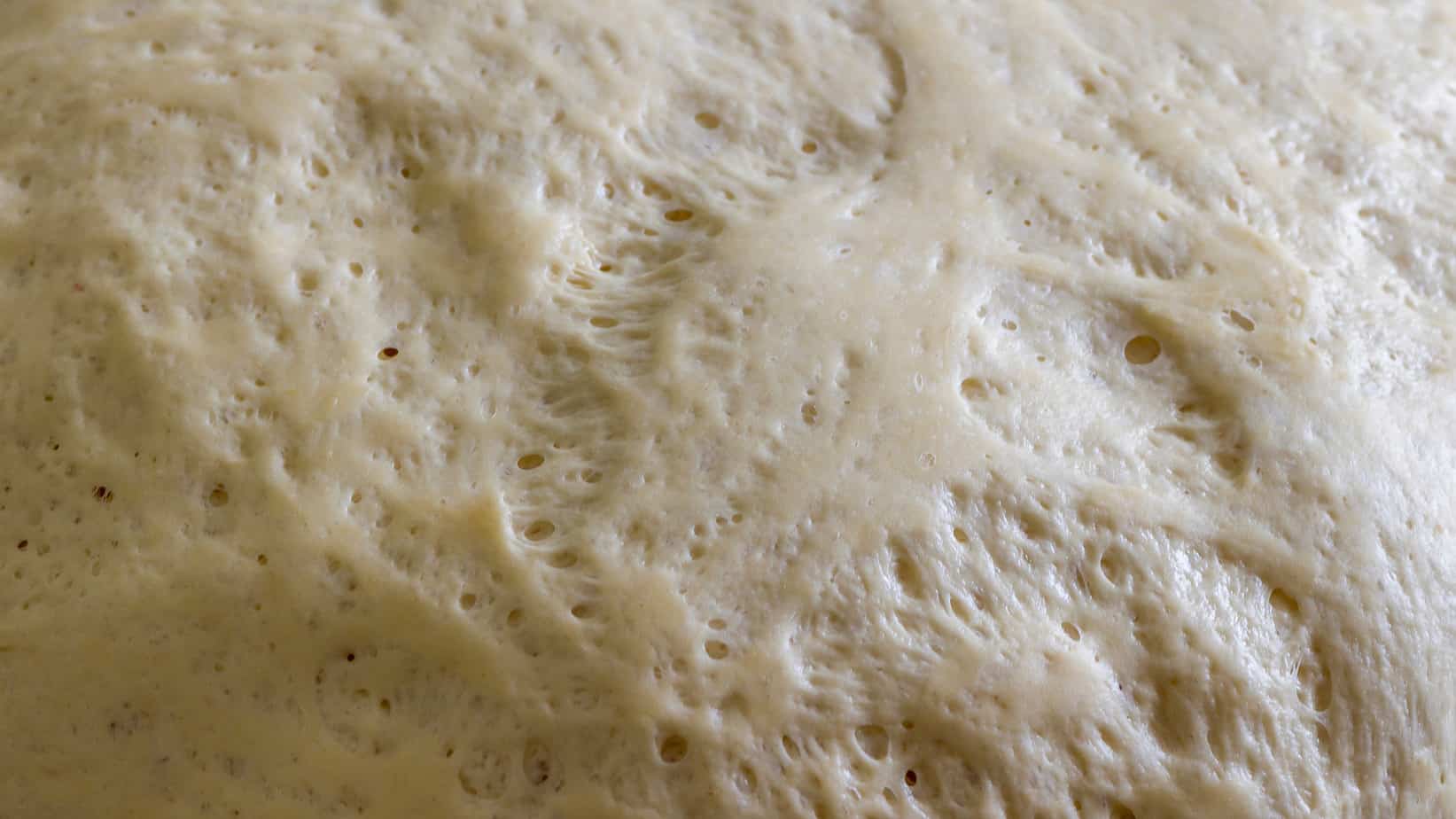
Thick crust pizza will be softer and chewier, undoubtedly more bread-like than anything else. In contrast, other pizza crusts call for crispier and thinner dough. Many pizza-style variants are somewhere in between.
Adding more water to flour makes your pizza dough hydration mixture much stickier. You can control this process easier by using a scraper and a controlled amount of dusting flour.
When you start forming a pizza dough shape, it helps to dust your working area lightly dusted with flour so the sticky dough doesn’t stick to you. You must also be careful with sticky dough since it will be fluffier as it ferments.
Sticky pizza doughs higher in water content will form larger bubbles in your dough, resulting in a crispier crust.
Effect of Pizza Dough Hydration on the Crust Structure (Hole Structure)
Pizza dough created through fermentation has a select amount of cell structure.
This structure is from the released gas from the chemical reaction of active yeast, water, and flour.
The oil added has a certain amount of influence, but mostly the mixture of flour, water, and yeast. The cell structure will create a wide variety of textures depending on the ratio of water to flour.
It can also alter the dough so the texture is softer, crispier, fluffier, and chewier.
These variations will all have considerable differences in the cell structure or how big or small the holes inside the dough look.
Hole Structure
Higher hydration doughs will have a more extensive hole structure, and larger air pockets, while lower hydration doughs will have a denser and smaller hole structure.
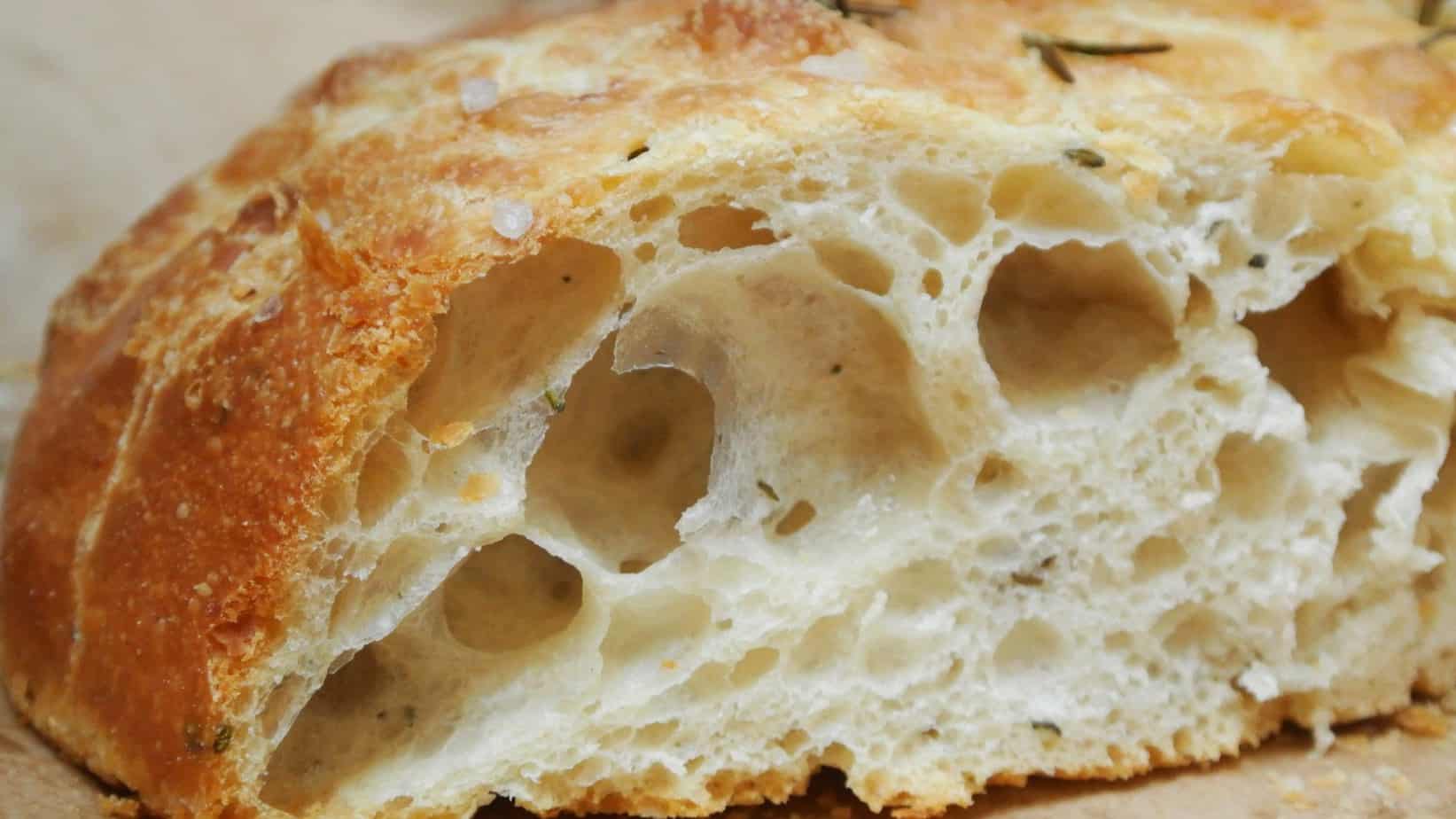
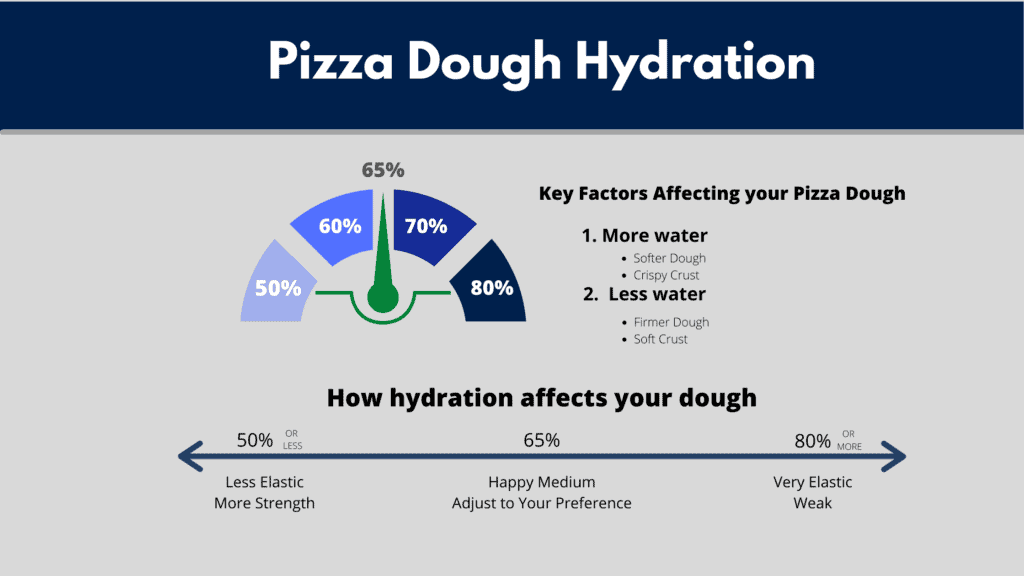
What is the Best Pizza Dough Hydration Percentage?
Determining the best pizza dough hydration percentage will depend on your choice of pizza dough since it depends on personal preference.
All pizza recipes will have different water ratios meant to define what type of pizza crust the dough will produce.
We always recommend starting at 65% hydration; this level will give a great result every time.
All our base recipes start at this 65% level. The ingredients incorporate well; the dough is easy to handle, has a manageable elasticity, and ferments 1 to 1 ½ hrs. (using active dry yeast).
We think it is the happy medium when starting to make pizza dough. From there, it’s the average or middle point in the spectrum, and you can adjust up or down depending on your preference.
An authentic Neapolitan pizza should have a dough hydration between 55-60%. You want fairly low hydration for Neopolitan pizza dough because you bake it in a wood-fired oven with a much higher temperature than a conventional oven.
Because pizzas are baked at a higher temperature, an airy crust can be achieved with lower hydration. The increased heat produces a greater oven spring. Oven spring is essentially the amount the dough rises when baking.
As far as pizza dough hydration is concerned, this is something that only experimentation will reveal. You might succeed more by carefully adjusting water ratios to get a more consistent dough and the desired result.
This process is how many people can find their favorite pizza dough recipe that always works. It also has everything to do with learning about baking and ingredient to yield the best results.
Creating the Perfect Balance
As a pizza baker, you will find the perfect balance according to your preference.
The only way to achieve this balance is by testing.
Try different pizza dough hydration levels and check which one you prefer.
The infographic shown below will give a summary of how these elements are related.
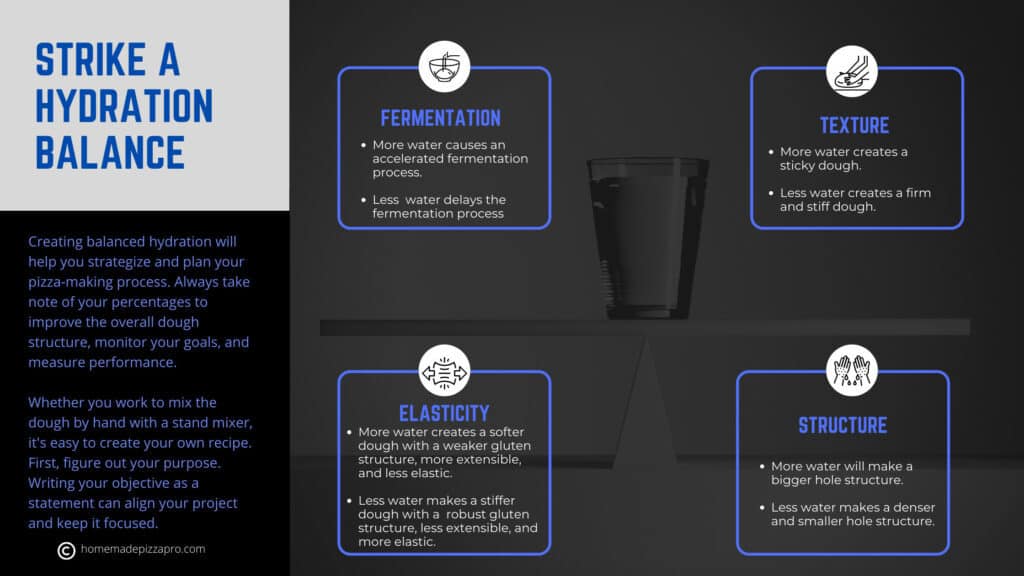
How to Know Which Pizza Dough Hydration Percentage is Best for You?
Three primary ratios define pizza dough hydration. Each one of these will create a dough that has radically different properties. Here is the run-through of what you can expect from each ratio.
To find which hydration percentage works best for you, Experiment! (Test) with three hydration percentages: 60, 70, and 80%; see the results of each and adjust accordingly to your preference.
We’ve done the homework, and here are the results:
60% Hydration
This produces a thicker and heavier dough that needs to be rolled out using a rolling pin. This dough won’t require much dusting with flour since this dough is so dry.
When lower hydration dough is baked, the result will be a very fine cell structure and chewy. A perfect example of how low hydrations affect pizza dough is the traditional Neapolitan pizza dough hydration, at 60%, provides the perfect structure and chewiness.
70% Hydration
High hydration dough is easier to work with since it can be considered middle-of-the-road. It’s dry enough to be hand-stretched with some dusting on your counter.
This type of dough inside has many large and small bubbles. It makes the crust easy to chew and still has plenty of crunch in some areas.
80% Hydration
Although this very wet dough is more elastic and has more water added, it’s the trickiest. It needs much managing while you stretch it out to make a pizza dough shape.
Higher hydration pizza doughs are very sticky and need extra flour dusting to stick to you or your working area. This hydration percentage creates the crispiest crust that will hold its shape after it’s baked.
Recommended Pizza Dough Hydration per Oven Temperature
Home Oven
Since most home ovens may not reach temperatures over 500 degrees Fahrenheit, you must make the most of what your oven can provide.
The average pizza hydration for a home oven will be around 60-65% and typically thin-crust pizza.
Thicker crust pizza is a unique art if you like specialty pizzas. With this level of hydration, you won’t have a burnt crust. Hotter ovens reaching 550F will have crusts closer to wood-fired oven results.
For thicker crusts, you need to have a baking pan that is high enough to bake 50-60% hydrated dough properly. This is why so many deep-dish pizza recipes call for olive oil to be coated in the pan first to fry the dough inside the pan.
To avoid having a soggy pizza, we recommend starting at 55% hydration and gradually working up to 65% as you become more comfortable with the dough.
Outdoor Pizza Oven
Luckily, outdoor pizza ovens will be much hotter than your kitchen oven. Wood-fired ovens and brick ovens can reach 1000 degrees Fahrenheit!
These high temperatures are the ideal temperature to bake a pizza faster. It can also burn a pizza with higher hydration of 60% and higher.
The moisture will quickly turn to steam and can burn your dough. It’s better to have dough below 60% if you use an outdoor pizza oven.
You must also watch your pizza and adjust it using your pizza peel. Continual turning and adjusting will give better results than letting it sit there.
Pizza Dough Hydration Resources

Best Water for Pizza Dough: Temperature, Quality, and Hydration
the PROs
In this article, we are going to dive deep into the mysterious ways of water. In conjunction with flour, yeast, and salt, it can make the most spectacular pizza dough.
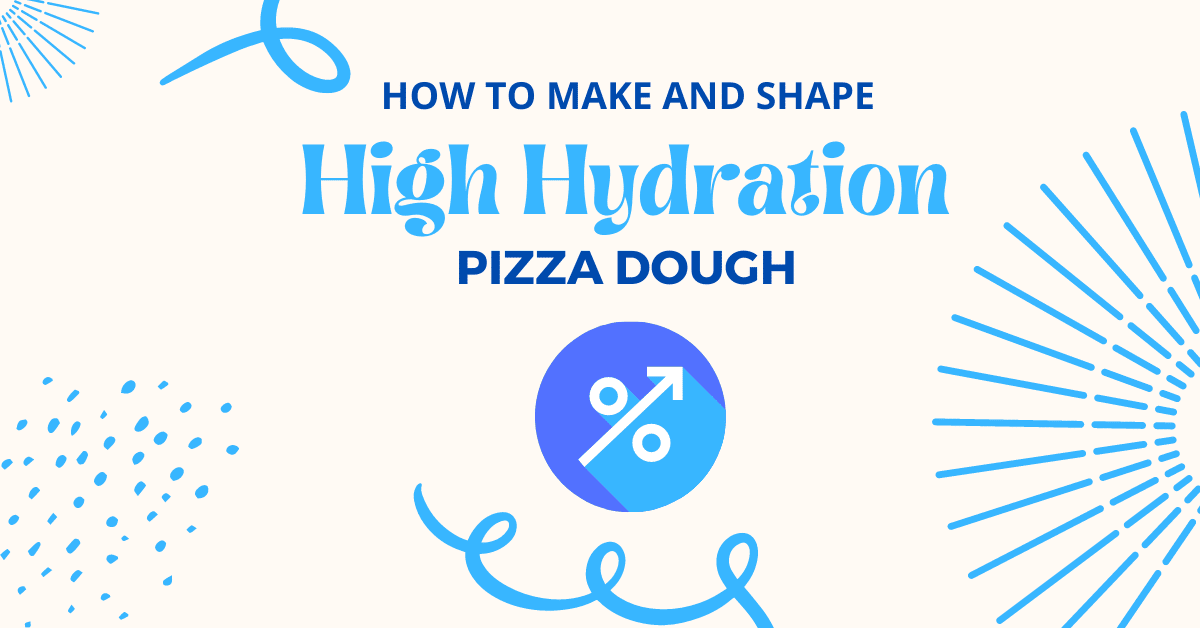
High Hydration Pizza Dough – Secret Ingredient to Perfectly Crispy Pizza
the PROs
Are you looking for a delicious, crunchy high hydration pizza dough recipe? This type of dough is very popular among …
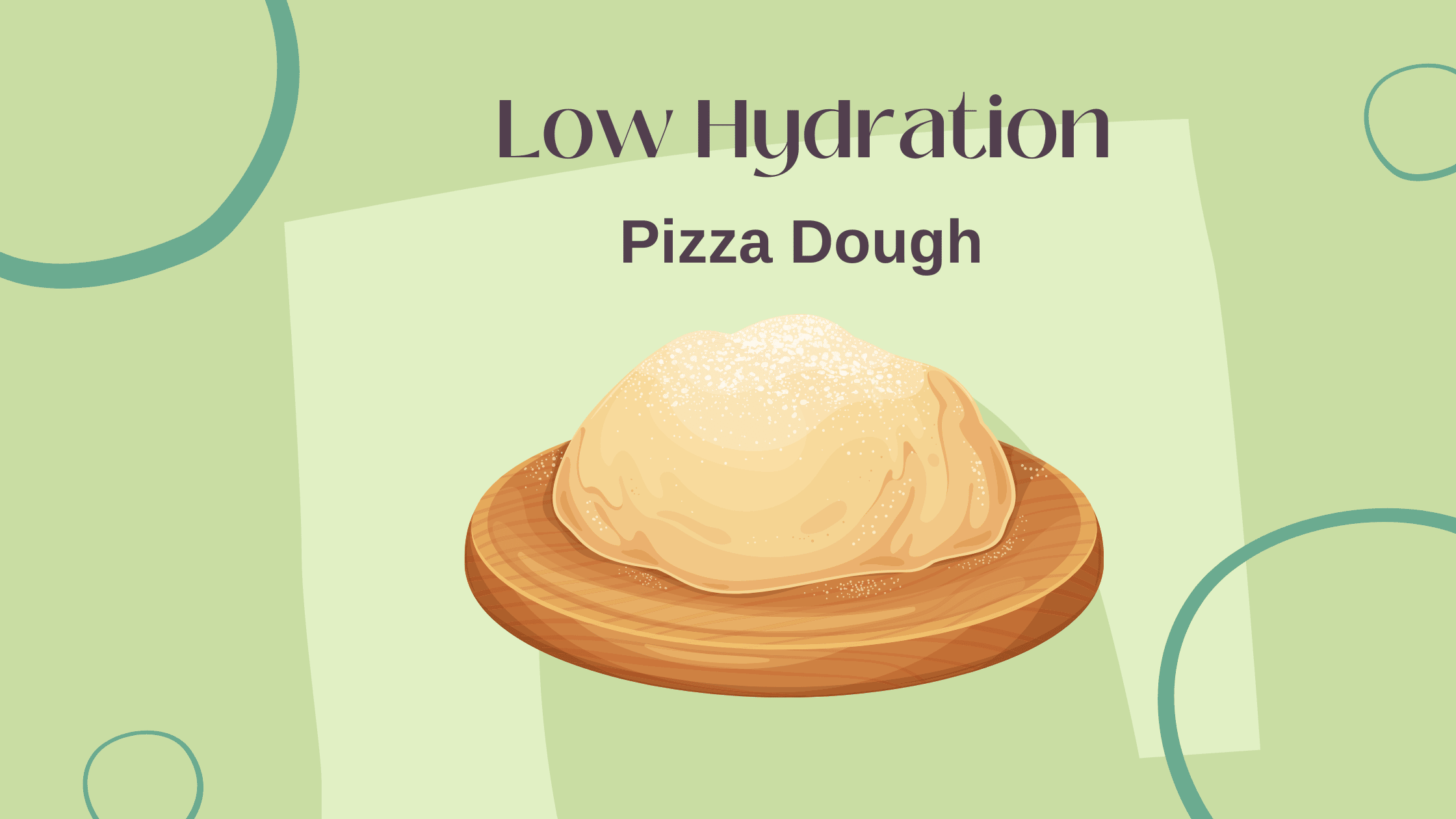
Low Hydration Pizza Dough: No More Soggy Pizza!
the PROs
Are you wondering what low-hydration pizza dough is? A pizza dough’s hydration is one of the most important factors when …
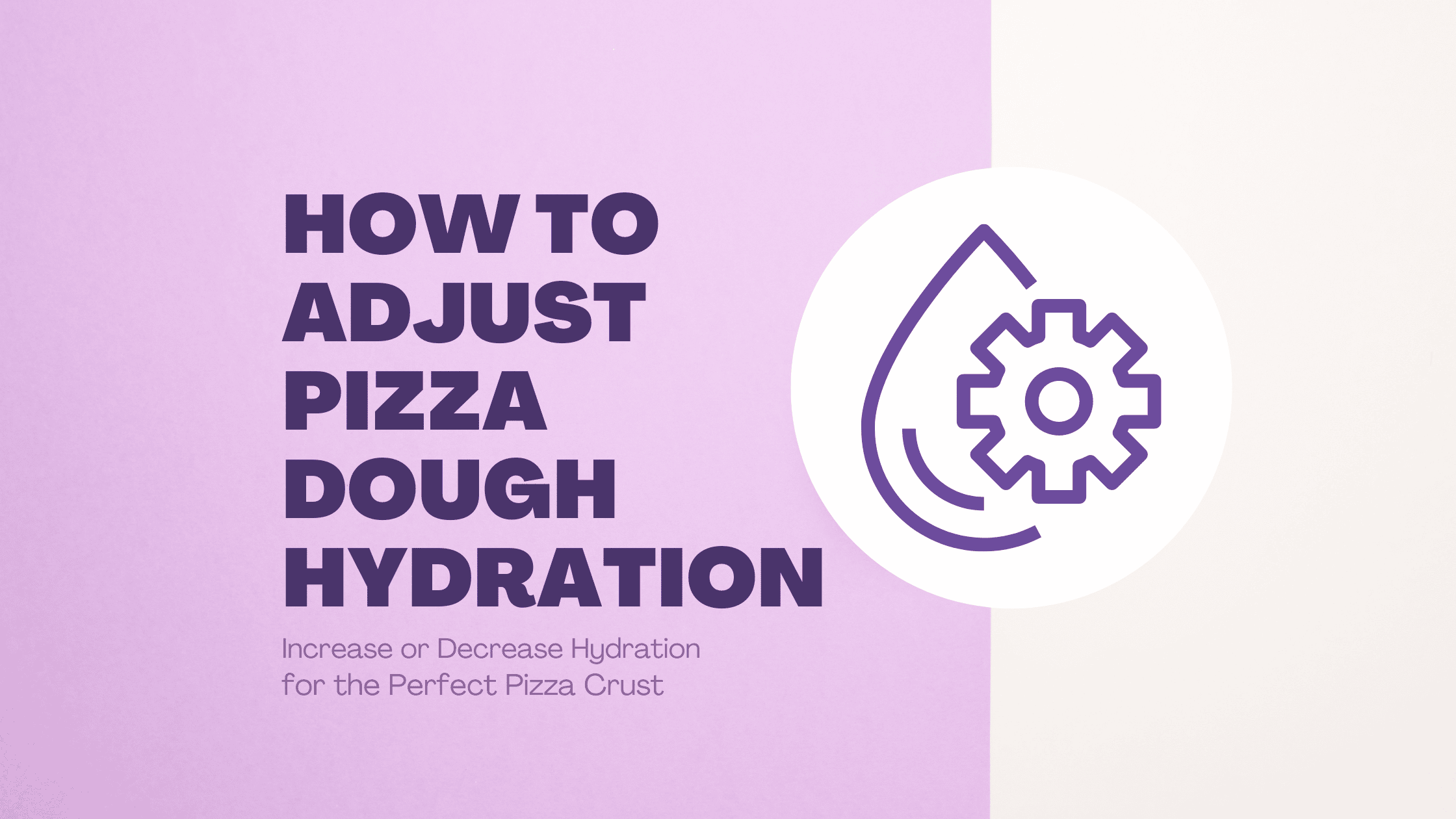
How to Adjust Pizza Dough Hydration Levels for a Perfect Crust
the PROs
How to Adjust Pizza Dough Hydration Making good pizza dough is an art form and one of the most important …

Flour Absorption 101: The Key to Crafting the Perfect Pizza Crust
the PROs
Ah, pizza. The one food that unites us all! What would we do without our delicious, cheesy slices of heaven? …
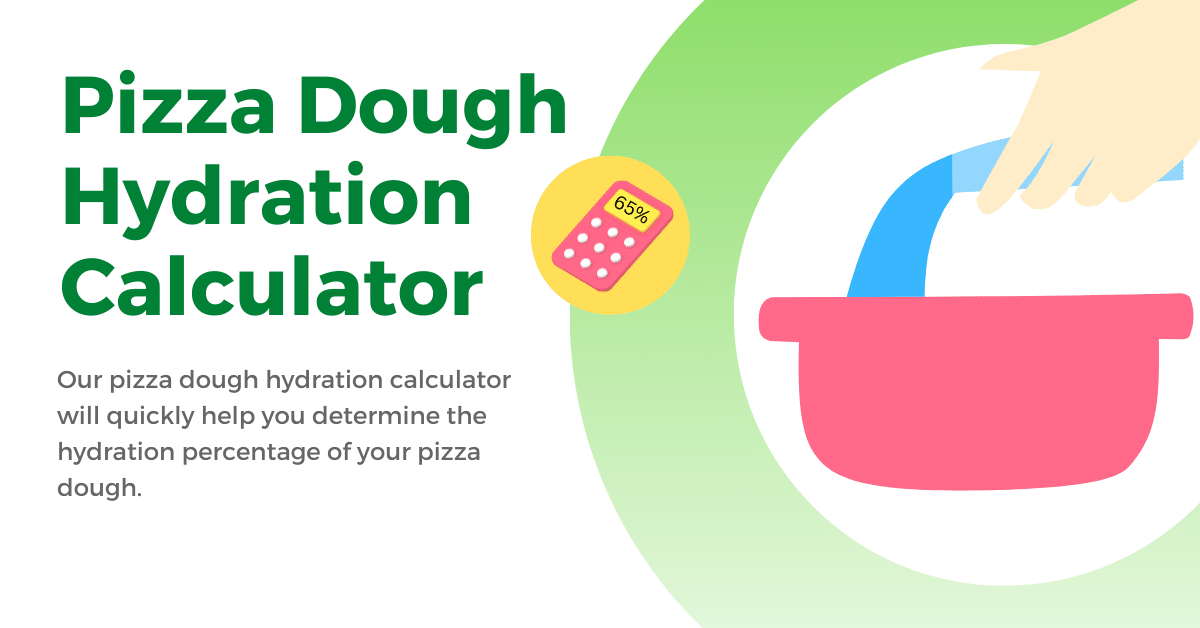
Pizza Dough Hydration Calculator
the PROs
Making the perfect pizza dough can be difficult, especially for novice bakers. But with the right tools, anyone can master …

7 Hydration Percentages by Pizza Style that Actually Make the Best Pizza
the PROs
Making a pizza is all about getting your pizza dough to have just the right amount of hydration. If you’re looking to get the best results this guide can help you find the specific pizza dough hydration according to your desired pizza style. Let’s check it out!

Here’s the Secret to Making the Perfect Crispy Pizza Crust
the PROs
Are you tired of making homemade pizza that has a crust that never seems to get crispy enough? We’ve got the answer to this problem! Our assortment of tips and methods will solve your problem once and for all. You’ll get better results in how to make a pizza crust crispy and crunchier than ever! So, let’s find out!
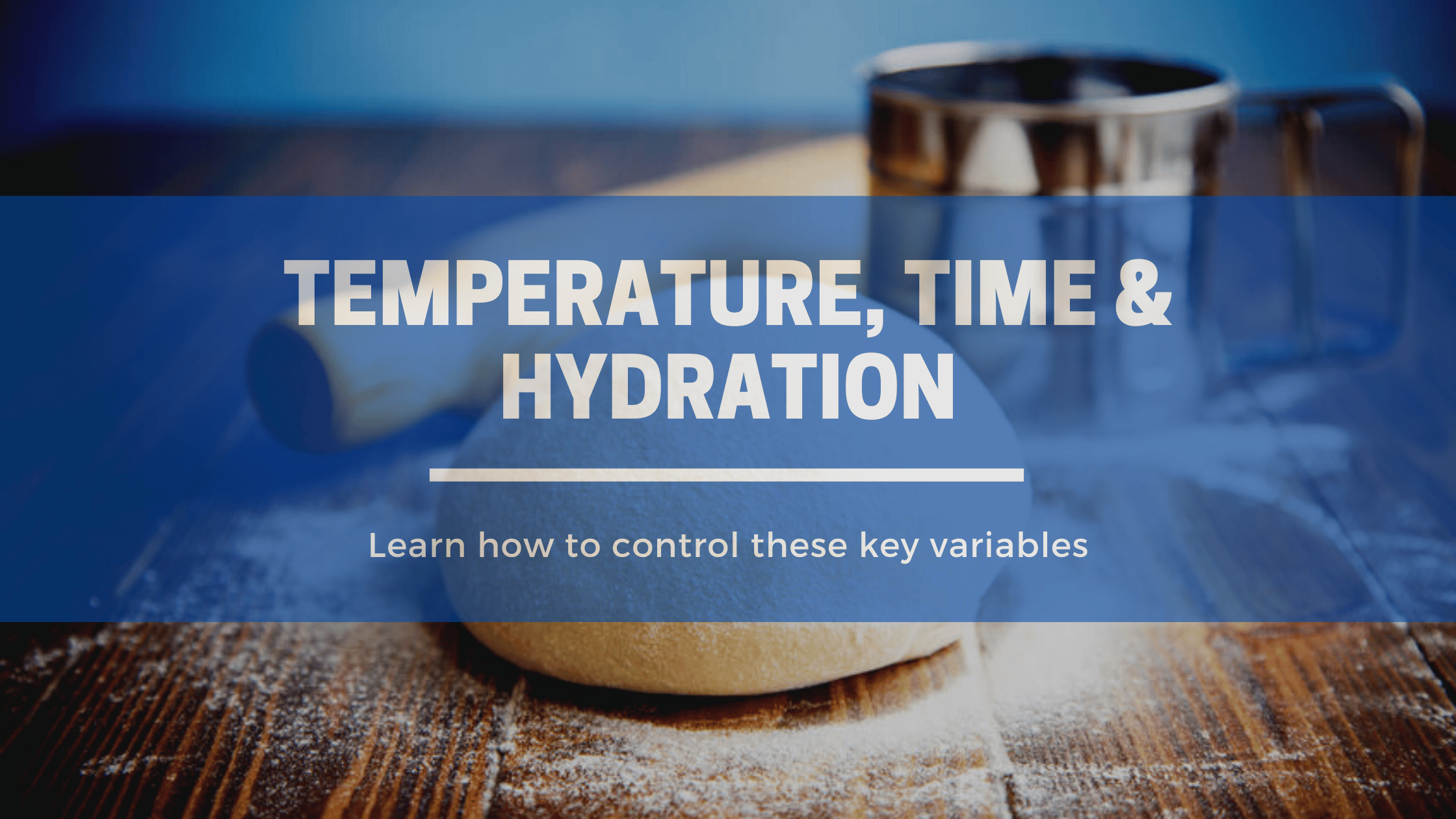
How to Control Temperature, Time, and Hydration for Pizza Dough
the PROs
Learn how temperature, time and hydration affect pizza dough and how you can control them.
If you’re unsure of a pizza dough recipe, don’t be shy to do a quick experiment. You’ll need to scale the recipe to one-quarter amounts for the ingredients.
This will give you a baseball-sized dough ball that you can store in a clear glass bowl. You can adjust the hydration accordingly if you don’t like the consistency. We recommend using a pizza dough calculator.
This calculator does your hard work and tells you how many ingredients you need and the recommended pizza dough hydration.
Here’s a video brought to you by Ooni on pizza dough hydration.
FAQs
What is the best hydration for Neapolitan pizza dough?
In general, 55% – 60% hydration is considered ideal for Neapolitan pizza dough. However, the ideal hydration will also depend on many factors, including the flour you use.
The Last Slice
Are you starting to get hungry for great pizza already?
We hope this pizza dough hydration guide has given you the confidence to make some great pizza immediately.
Better yet, you can share this guide with others who want to try making pizza at home.
Now that you have a better idea about pizza dough hydration, you can’t go wrong with making the perfect pizza dough!
Related Pizza Dough Articles

How to Mix Pizza Dough
the PROs
Do you want to learn how to mix pizza dough? Pizza dough is a staple in most households, but it …

Best Water for Pizza Dough: Temperature, Quality, and Hydration
the PROs
In this article, we are going to dive deep into the mysterious ways of water. In conjunction with flour, yeast, and salt, it can make the most spectacular pizza dough.

Salt in Pizza Dough: The Secret to a Perfectly Seasoned Crust
the PROs
Making homemade pizza is not complicated; see how with just a few ingredients like flour, water, yeast, and salt you can do wonders. In this article, we will discuss the role of salt in homemade pizza and discover four (4) basic rules applicable to salt, that are easy to remember that will make you a better homemade pizza baker.
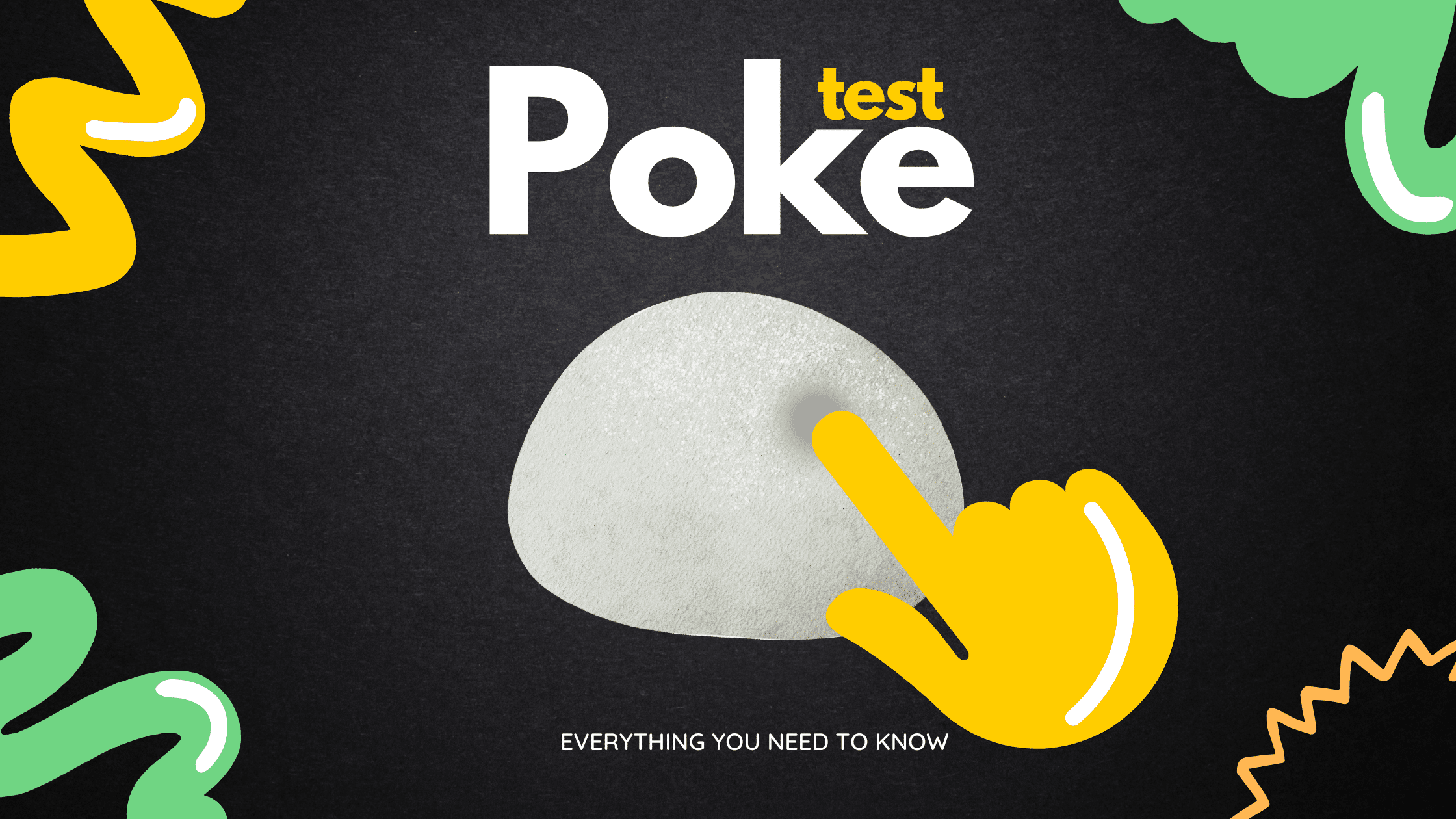
Poke Test Demystified: Master the Technique for Perfect Pizza Every Time
the PROs
Are you tired of ending up with a pizza crust that’s either too thick or still raw in some parts, …
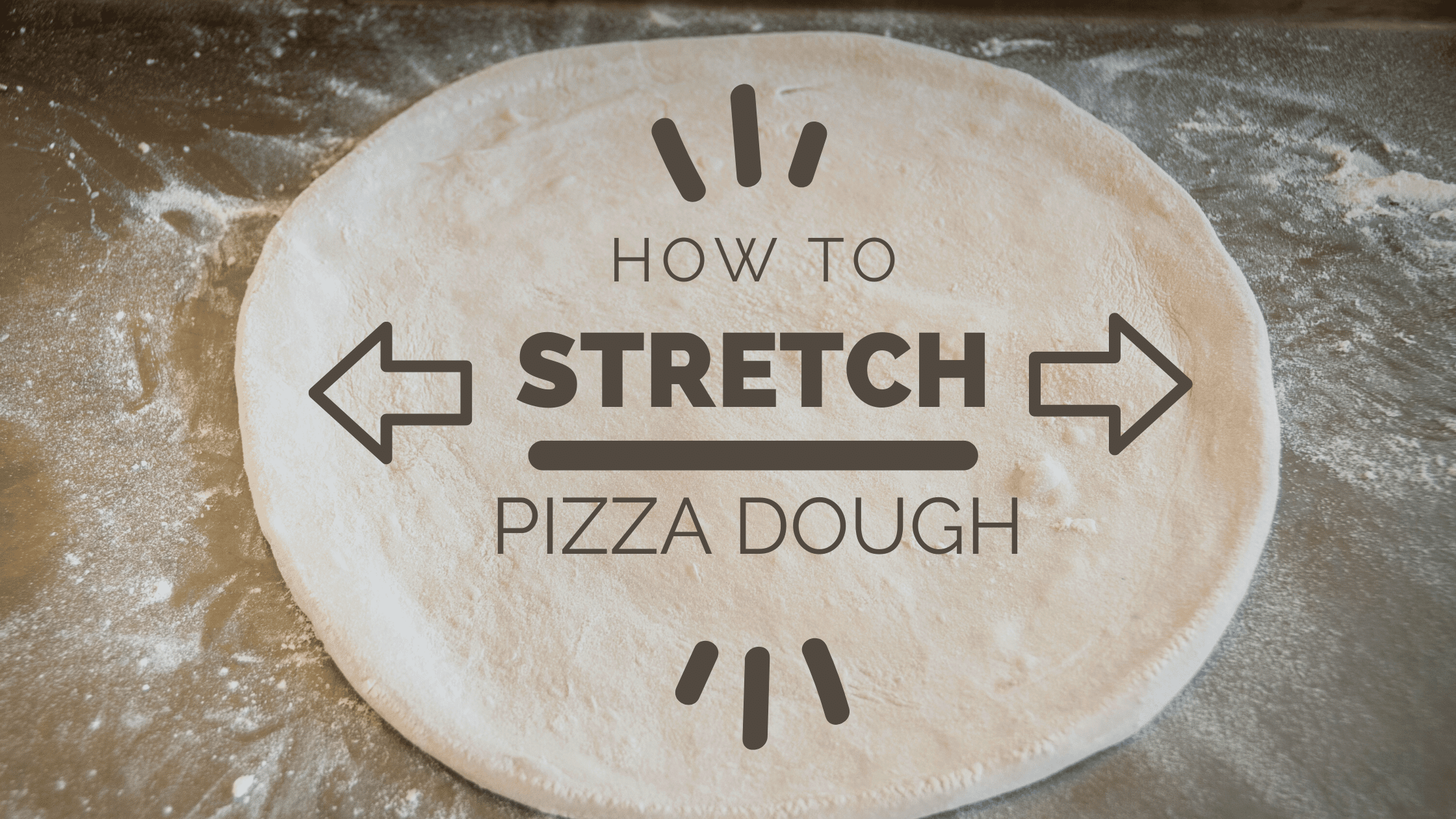
How to Stretch Pizza Dough Like a PRO: Tips and Tricks to Elevate Your Homemade Pizza Game!
the PROs
So you’ve decided to make your pizza but are unsure how to stretch pizza dough to perfection. Well, fear not! …
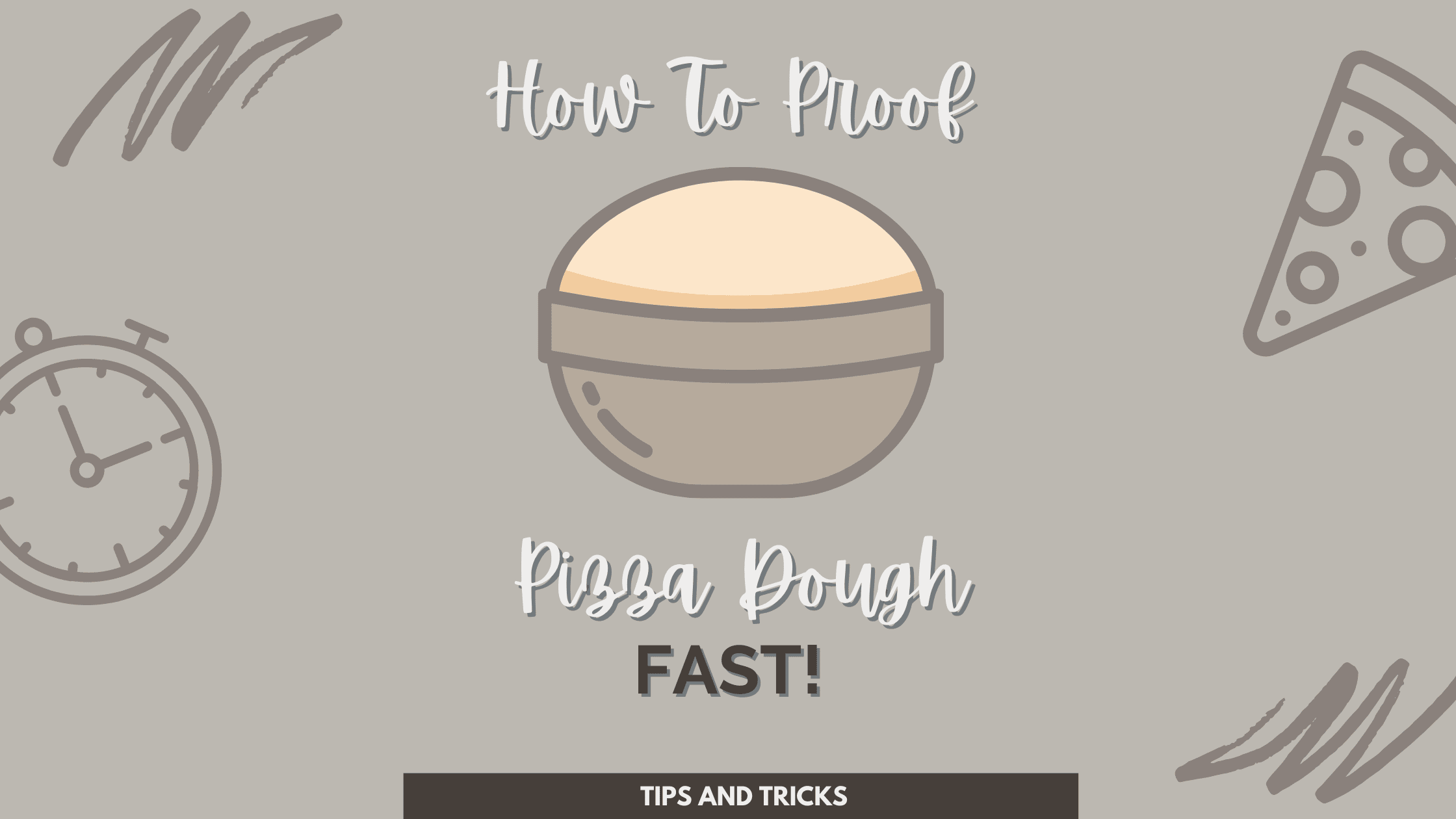
How to Proof Pizza Dough Fast
the PROs
How to Proof Pizza Dough Fast Behind every tasty pizza dough is a secret. Secrets behind its fantastic flavor and …
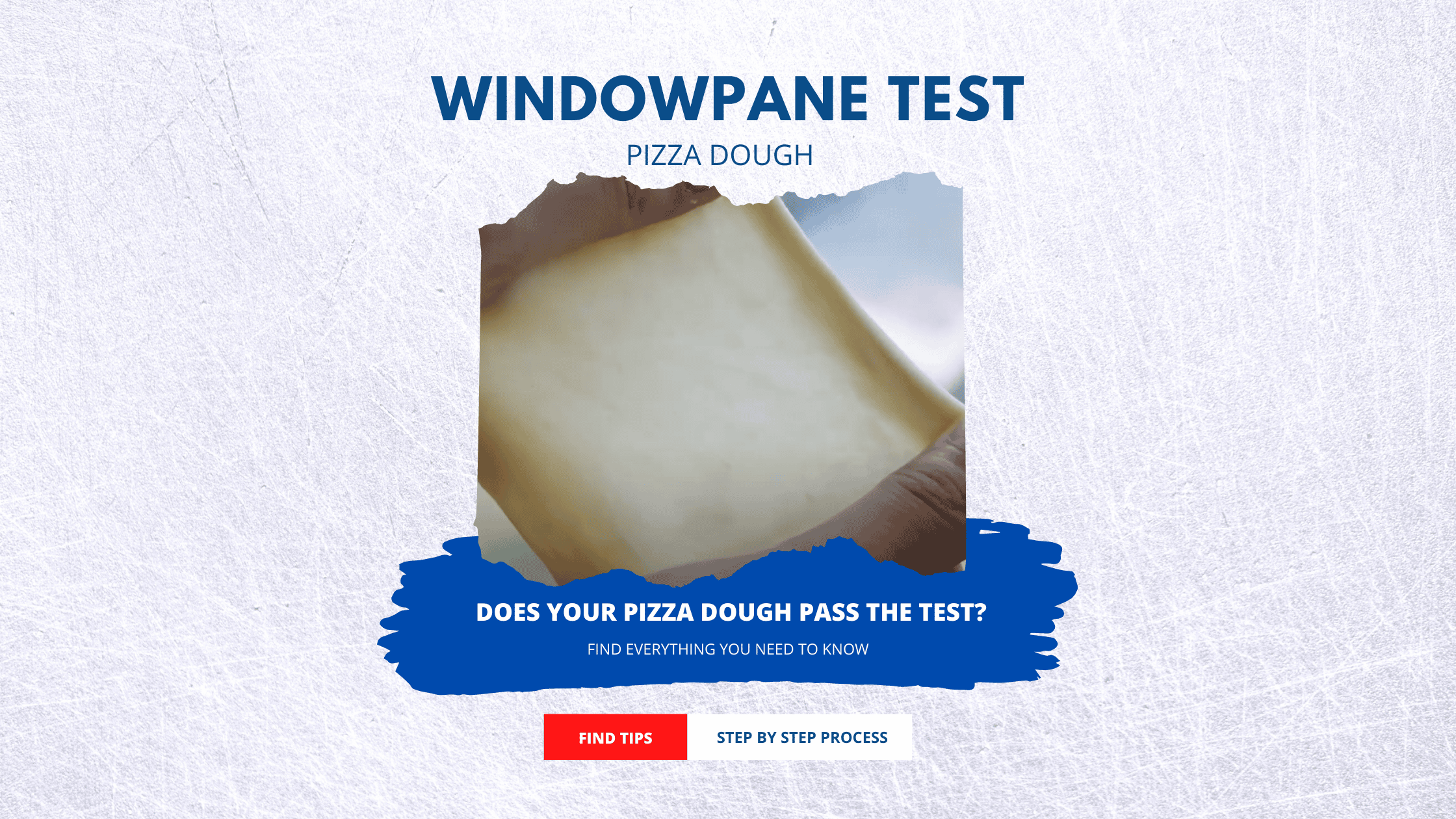
Windowpane Test: (Tips, How-to, and Everything You Need to Know)
the PROs
Pizza Dough Windowpane Test Kneading the dough is probably one of the most complex parts of baking a pizza. You …

Can You Freeze Pizza Dough? (Everything You Need to Know)
the PROs
How to Freeze Pizza Dough Are you wondering how to freeze pizza dough? Most of us know that putting things …
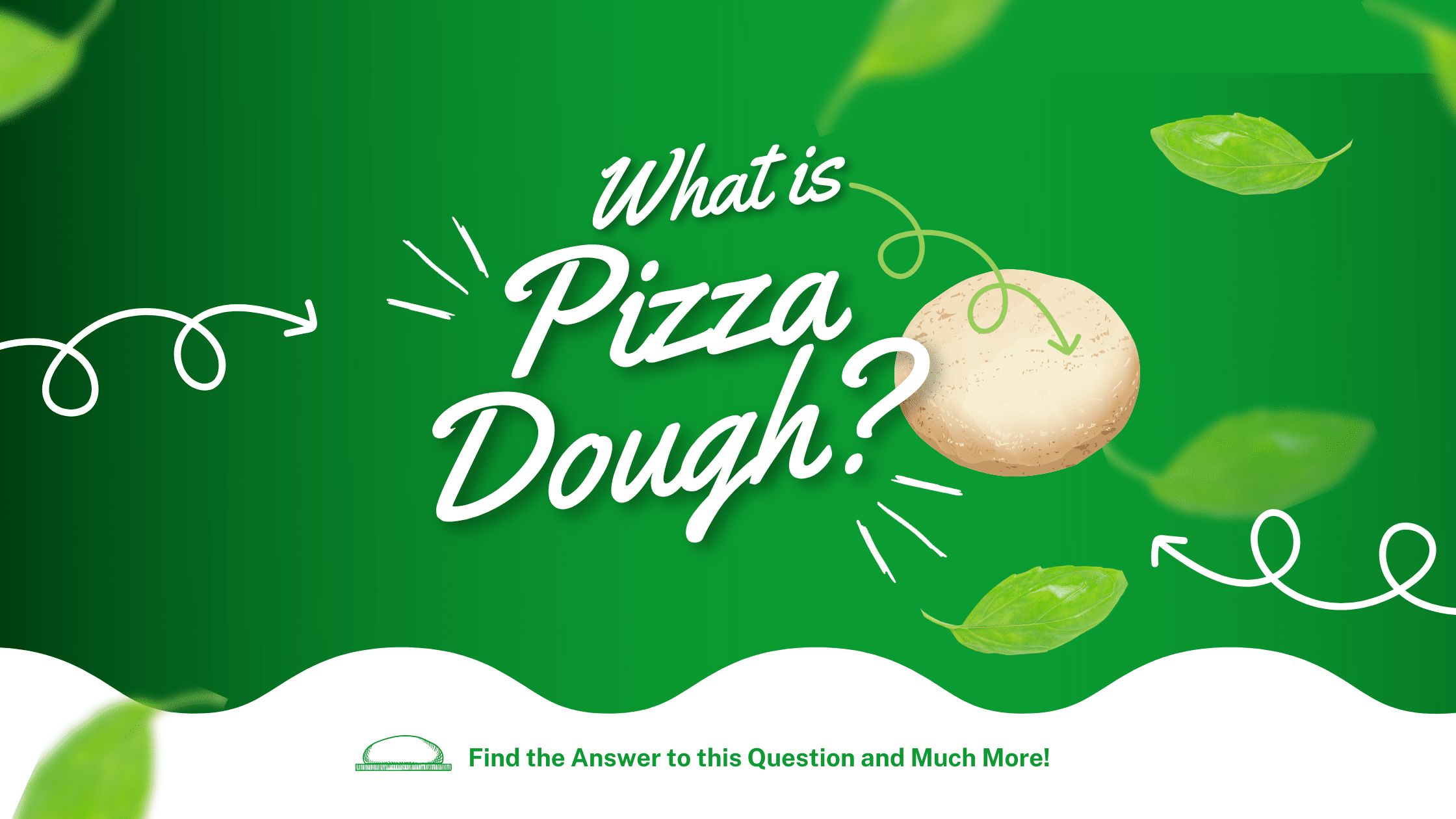
What is Pizza Dough? Here’s What You Need to Know and How to Make It
the PROs
Pretty much everyone likes pizza. But when you first start making pizza at home, you can feel a little overwhelmed. …
Enjoy!
Not a PRO? Not a Problem!
Take a pizza class to bring your pizza skills to the next level,
so you can be a PRO!
Related Posts

Costco Pizza Delivery: Find How You Can Get It Now!
the PROs
People go to Costco’s food court for many different reasons, but the cheesy slice of pizza they serve is among …

Pizza for Beginners: Don’t Buy Pizza, Make It! Here’s How to Get Started!
the PROs
You have this idea that you want to make pizza at home as opposed to ordering it, but where do you start? Don’t worry! Here you will find answers and directions to all your questions.

Pizza Toppings Under Cheese or Over Cheese? [Why the Order Matters]
the PROs
Is Pizza Cheese on Top or Bottom? Hey pizza lovers, are you wondering if you should layer pizza toppings under …
Newsletter
Subscribe to our Recipe of the Week newsletter and receive our partners’ latest recipes, tips, and discount offers.
Keep in Touch!
